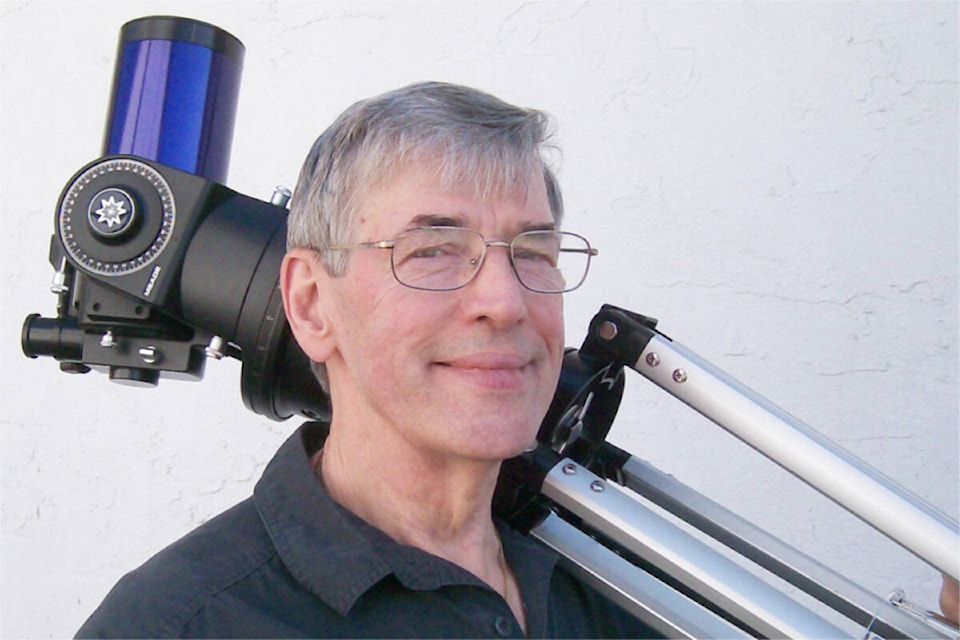Back in the days of “the right stuff,” the two big players in the space race of the late 1950s and early ’60s were the U.S. and the former Soviet Union.
Aside from a couple of Soviet launches – Sputnik satellite and Yuri Gagarin’s first orbital flight – that grabbed U.S. Pentagon and the White House attention, the main focus for much of the Western world was on the American accomplishments and failures as the two nations raced to be first to land humans on the moon. It was a comparatively peaceful, albeit noisy and expensive competition that evolved out of the military side of aerospace development.
Nanaimo Astronomy Society’s guest speaker for its next meeting is David Prud’homme, PhD, a volunteer instructor at Vancouver Island University’s ElderCollege and former president of the Edmonton centre of the Royal Astronomical Society of Canada, who has had a lifelong interest in the Russian and Soviet Union’s secretive space program.
As a child during the space race, Prud’homme was fascinated by the early manned space missions, but when the secrecy of the former U.S.S.R.’s space program was lifted, he was surprised by what he learned when he visited the country in 1973.
“I went to their cosmos pavilion at the Exhibition of Economic Achievements and I learned a little more about the space program there that had been relatively kept secret in North America,” Prud’homme said. “The biggest thing with the Russians is that a lot of what we knew about their space program, we didn’t actually know until the ’80s when a lot of this stuff was suddenly revealed for the first time. So, people don’t have, shall we say, a living memory of the actual things that happened and I want to talk, both about their early successes, as well as their tragedies.”
READ ALSO: Nanaimo Astronomy Society’s guest speaker will share the thrill of meteorite hunting
Prud’homme will discuss the lead-up to the U.S.S.R.’s manned space program and give a comparison of the American and Soviet missions in the 1960s and how astronauts and cosmonauts fared in flight and immediately after they returned to Earth.
“Other than the Apollo 1 tragedy, most of our astronauts, when they came back to Earth, they were fine. They got rescued, as they should … but other than that, most missions, they came back pretty much healthy,” Prud’homme said.
But when cosmonauts, such as Alexei Leonov – the first human to perform a space walk in March 1965 – and his crew mate Pavel Belyayev landed back on Earth on hard ground in Kazakhstan, their experience was much different from that of their American counterparts, who were retrieved by the U.S. Navy after splashing down in the ocean.
“They came down in the middle of a forest and they had to spend the night in their spacecraft with howling wolves nearby and they couldn’t get rescued. They actually had to ski out,” Prud’homme said.
In another incident, a cosmonaut’s capsule re-entered the Earth’s atmosphere at the wrong angle and nearly burned up, though he and the craft survived what proved to be a very rough ride.
“It landed 200 kilometres from where it should have been,” Prud’homme said. “It was 38 degrees below zero and he knew he wouldn’t be rescued, so he saw smoke in the distance and, with broken teeth – because his teeth broke when he landed – he walked several kilometres to a peasant’s hut so he could be rescued and not freeze to death.”
More tales of tragedy and triumph of the Soviet and Russian space programs will be presented Thursday, April 27, at 7 p.m. at the Beban Park social centre and streamed online for astronomy society members. Vancouver Island University third-year astronomy students will also be giving a talk.
To learn more about the meeting and Nanaimo Astronomy Society, visit www.nanaimoastronomy.com.
READ ALSO: Astrophysicist explains the science behind the beauty of the cosmos to Nanaimo astronomers
chris.bush@nanaimobulletin.com
Like us on Facebook and follow us on Twitter
